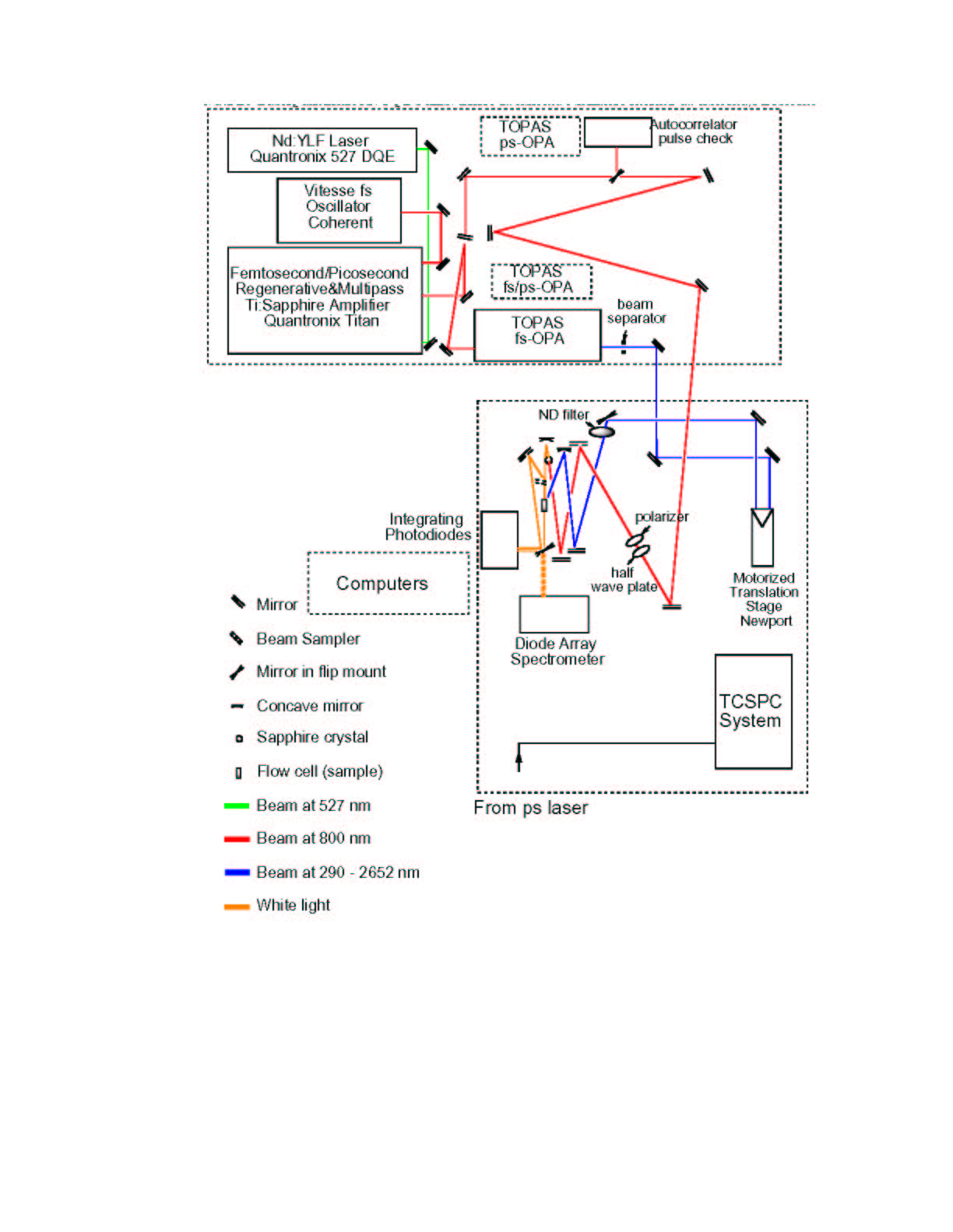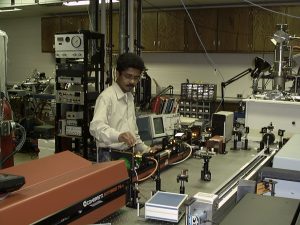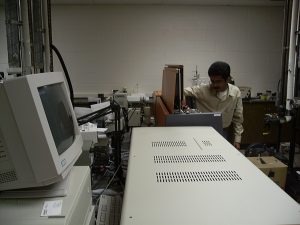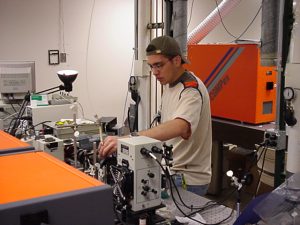Welcome to our labs! We hope you enjoy the tour through our
Laser Spectroscopy and synthetic labs.
Femtosecond Optical Spectroscopy
I use a dual femtosecond/picosecond, regeneratively amplified dual OPA laser system, allowing us to examine photophysical events with femtosecond resolution. The system has a Nd:YLF pump and a Coherent Ti:Sapphire seed lasers pumping a pair of TOPAS OPAs. I have a diode array spectrometer and a delay line capable of measuring 0 – 4 ns and 0 – 8 ns. A schematic of our setup is also shown below.
 |  |
 |  |

Picosecond Optical Spectroscopy
Time-correlated single photon counting (TCSPC) experiments are performed with a Nd:YLF pump laser and a Coherent 702 dye laser and uses a red-sensitive Hamamatsu microchannel plate PMT. Data collection is done through a Becker & Hickl/Edinburgh Instruments detection system. The time resolution on this system is ~5 ps with reconvolution.

Dr. Rishi Rajesh making adjustments to the picosecond dye laser.
Nanosecond Optical Spectroscopy
Experiments on the nanosecond time-scale are performed with the transient absorption/time-resolved spectrometer shown below. This system uses either (or both) a Spectra-Physics PRO-190 Nd:YAG pumped Lambda-Physik Scanmate 2E dye laser or a Lambda-Physik Compex 102 excimer laser, and both ICCD and PMT detectors for transient absorption and time-resolved experiments, respectively. This system has a time-resolution of ~6-8 ns. Pulse energies on this system are 15-150 mJ throughout the UV-Vis.

Dr. Rishi Rajesh adjusting the focussing lens on the dye amplifier portion of the nanosecond Nd:YAG pumped dye laser for the nanosecond laser flash photolysis system.

Elvin Aleman adjusting the focussing lens on the excimer laser used in the Modarelli Group nanosecond laser flash photolysis system.
Steady-State Fluorescence Spectroscopy
The fluorometer/phosphorimeter in our group is a SPEX Fluorolog-322 fluorometer.
Typical Experiments Using the Photophysical Equipment within the Modarelli Group:
Time-correlated single-photon counting (TCSPC) measurements for determining electron-transfer rate constants (kET)
Time-resolved fluorescence anisotropy measurements for determining energy transfer (kEET) rate constants and molecular tumbling motions
Femtosecond pump-probe measurements for determining energy (kEET) and electron-transfer (kET) rate constants
Nanosecond laser flash photolysis (LFP) experiments to determine the lifetimes of reactive intermediates, and the rate constants of their reactions with different substrates
Nanosecond LFP experiments to examine the photophysics of excited states
Two-photon two-color condensed phase pump-pump-probe experiments, where one photon is first used to excite a molecule, a second photon of different color is used to excite to a second state, and then the monitoring beam of the LFP system is used to interrogate the excited transient species
Steady state fluorescence experiments to determine the quantum yields of fluorescent states, and thereby electron-transfer events
Single molecule fluorescence spectroscopy to measure energy Donor-Acceptor distances
Low-Temperature Matrix Spectroscopy
We are in the process of constructing an APD Displex cryo-system for performing matrix-isolation experiments in the 12-300 K range. Experiments that will be run on this instrument will include matrix-isolation spectroscopy (IR, UV-Vis, fluorescence) of reactive intermediates such as carbenes, strained alkynes, radicals and radical ions.
Synthesis
Our group occupies one and a half wet labs with seven hoods. The bulk of our synthetic efforts focus on synthesizing dendrimers containing electron-donor and electron-acceptor groups that are capable of undergoing photoinduced electron-transfer reactions, while a portion of our efforts are toward synthesizing precursors for reactive intermediates. In this photo Susan Cramer performs some manipulations in her hood.